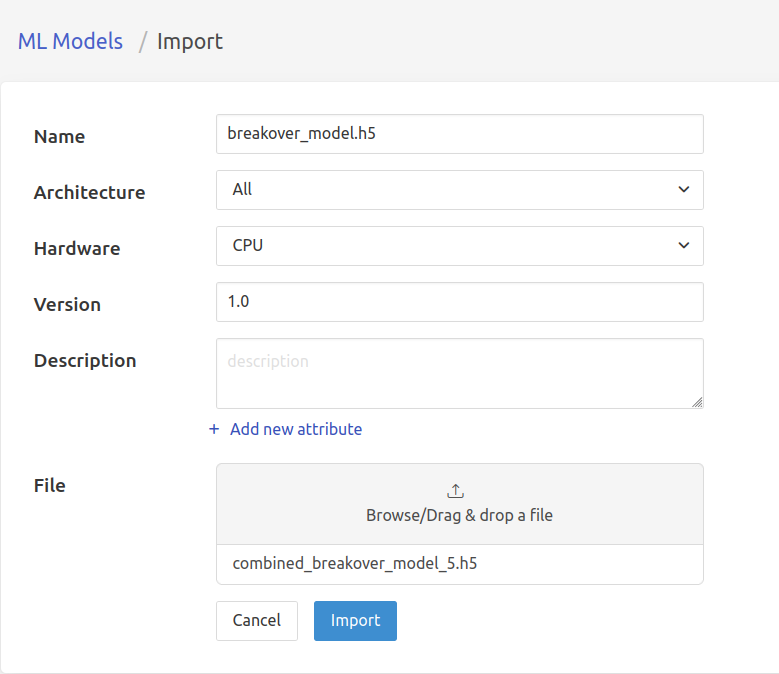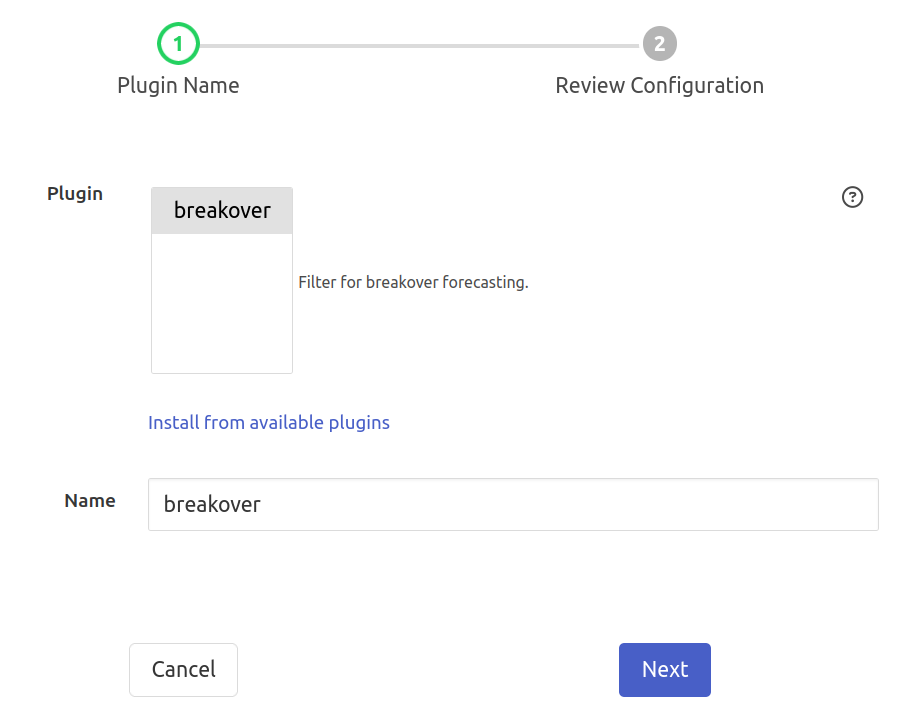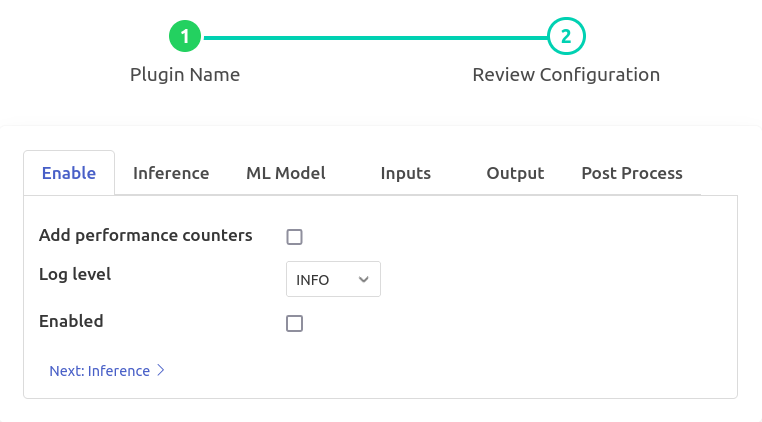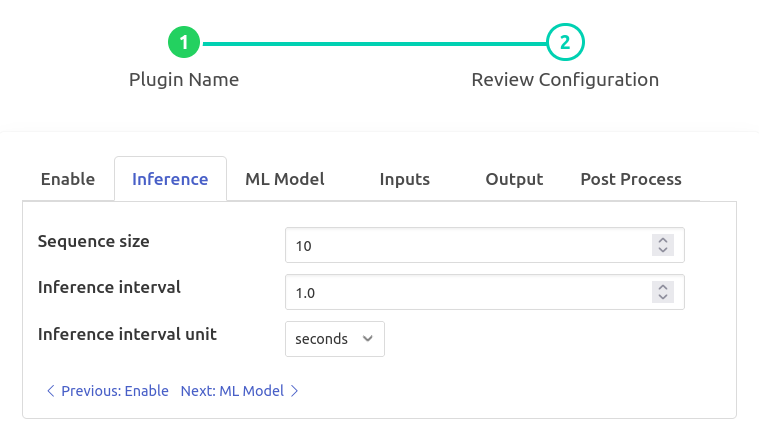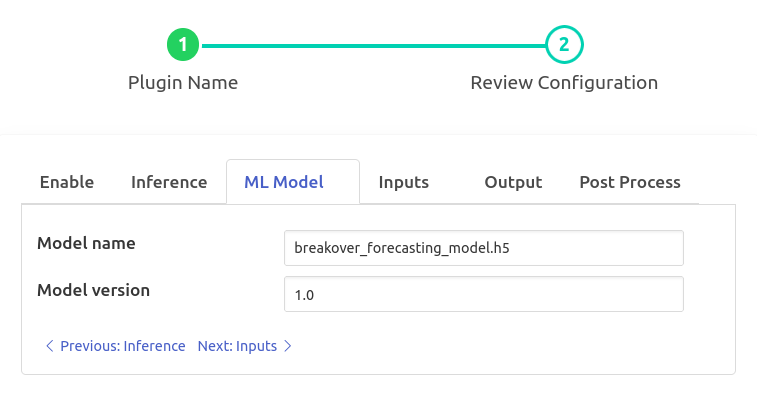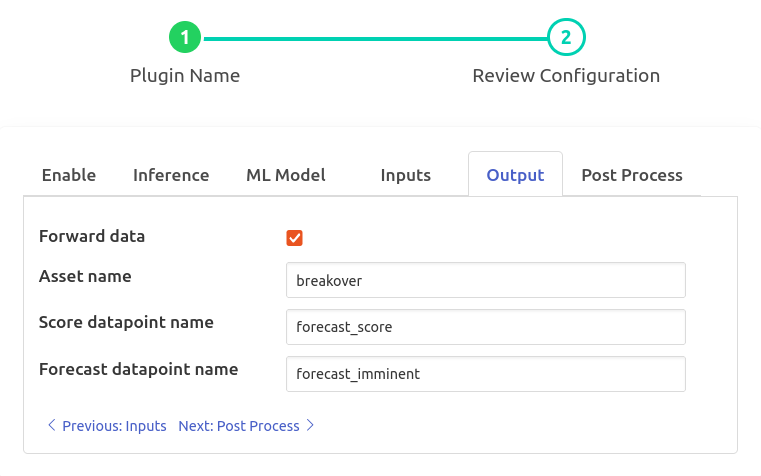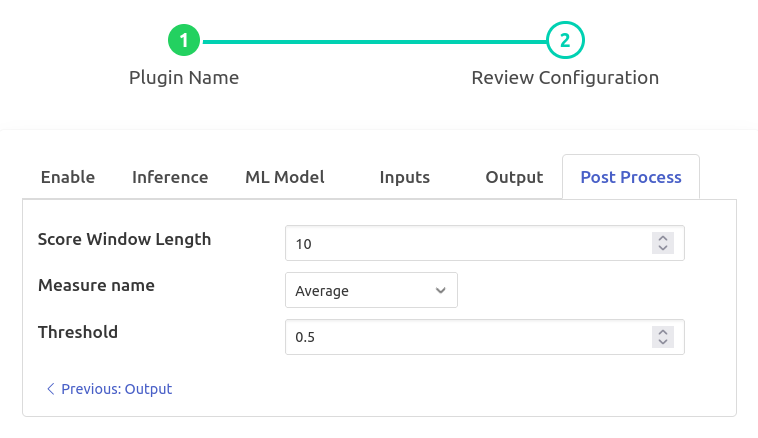Filter Plugin For Breakover Prediction¶
flir-filter-breakover forecast the possibility of breakover. The output of this plugin can appear as follows
1. Setting up your artifacts¶
The trained model from keras needs to be in .h5 format for its usage in this filter.
models/
├── breakover_forecasting_model.tflite
└── breakover_forecasting_model.h5
2. Setting up bucket¶
Make sure flir-gui-ml-models and flir-service-bucket is installed. If not, install these.
Click on “ML Models” in FLIR Bridge GUI
Click on import, and set the appropriate values. Then upload the prepared model above. e.g.
Name: "breakover_model.h5"
Architecture: All
Hardware: CPU
Version: "1.0"
Description: ""
File: "models/breakover_forecasting_model.h5"
3. Setting up plugin configuration¶
Configuring the filter, starts with selecting the filter and giving an application name for it. The screen will look like the following.
Following this the next screen will have the plugin configuration as shown below:
- ‘Add performance counters’: type: `boolean` default: ‘false’:
Add performance counters metadata containing resource utilization statistics.
- ‘Log level’: type: `enumeration` default: ‘INFO’:
Log level for diagnostic or error output.
Options are:
ERROR
WARN
INFO
DEBUG
- ‘Enabled’: type: `boolean` default: ‘false’:
Enable breakover forecast filter plugin.
- ‘Sequence size’: type: `integer` default: ‘10.0’:
Sequence size that is to be used for breakover forecasting.
- ‘Inference interval’: type: `float` default: ‘1.0’:
Time interval after which the data will be passed through the model.
- ‘Inference interval unit’: type: `enumeration` default: ‘seconds’:
Time interval unit.
Options are:
seconds
minutes
hours
- ‘Model name’: type: `string` default: ‘breakover_forecasting_model.h5’:
Model to be loaded from bucket service.
- ‘Model version’: type: `string` default: ‘1.0’:
Model version as stored in bucket.
List of objects are to be added in this group. Object properties are as below:
- ‘Asset name’: type: `string` default: ‘asset_1’:
Enter input asset name.
- ‘Datapoint name’: type: `string` default: ‘datapoint_1’:
Enter input datapoint name.
- ‘Feature type’: type: `enumeration` default: ‘Boolean’:
Datatype of the feature.
Options are:
Boolean
Numeric
- ‘Scaling strategy’: type: `enumeration` default: ‘None’:
The strategy that is to be used for data scaling.
Options are:
None
Normalization
Standardization
- ‘Minimum’: type: `float` default: ‘-1.0’:
Enter minimum value for data normalization.
- ‘Mean’: type: `float` default: ‘-1.0’:
Enter mean value for data standardization.
- ‘Maximum’: type: `float` default: ‘-1.0’:
Enter maximum value for data normalization.
- ‘Standard deviation’: type: `float` default: ‘-1.0’:
Enter standard deviation value for data standardization.
- ‘Forward data’: type: `boolean` default: ‘true’:
Whether to forward received PLC data down the filter chain.
- ‘Asset name’: type: `string` default: ‘breakover’:
Name of asset that indicates breakover forecast.
- ‘Score datapoint name’: type: `string` default: ‘forecast_score’:
Name of datapoint that indicates breakover forecast score.
- ‘Forecast datapoint name’: type: `string` default: ‘forecast_imminent’:
Name of datapoint that indicates breakover forecast.
- ‘Score Window Length’: type: `integer` default: ‘10’:
Number of score values that is to be used for breakover forecasting.
- ‘Measure name’: type: `enumeration` default: ‘Average’:
Measure to calculate on the scores value present in the window.
Options are:
Summation
Minimum
Average
Median
Maximum
Standard Deviation
Variance
- ‘Threshold’: type: `float` default: ‘0.5’:
Threshold to apply on the calculated measure value.
Click on Done when ready.
See Also¶
flir-filter-ADM_LD_prediction - Filter to detect whether a large discharge is required for a centrifuge
flir-filter-edgeml - Filter which takes image data, calls out to ML process, and forwards the inference from ML as asset contents.
flir-filter-expression - A FLIR Bridge processing filter plugin that applies a user define formula to the data as it passes through the filter
flir-filter-fft - A FLIR Bridge processing filter plugin that calculates a Fast Fourier Transform across sensor data
flir-filter-log - A FLIR Bridge filter that converts the readings data to a logarithmic scale. This is the example filter used in the plugin developers guide.
flir-filter-normalise - Normalise the timestamps of all readings that pass through the filter. This allows data collected at different rate or with skewed timestamps to be directly compared.
flir-filter-python35 - A FLIR Bridge processing filter that allows Python 3 code to be run on each sensor value.
flir-filter-rms - A FLIR Bridge processing filter plugin that calculates RMS value for sensor data
flir-filter-scale-set - A FLIR Bridge processing filter plugin that applies a set of sale factors to the data
flir-filter-specgram - FLIR Bridge filter to generate spectrogram images for vibration data
flir-filter-statistics - Generic statistics filter for FLIR Bridge data that supports the generation of mean, mode, median, minimum, maximum, standard deviation and variance.
flir-filter-vibration_features - A filter plugin that takes a stream of vibration data and generates a set of features that characterise that data
flir-south-ABB - A south plugin to pull data from the ABB cloud
flir-south-Beckhoff - A Beckhoff ADS data ingress plugin for FLIR Bridge, this monitors Beckhoff PLCs and returns the state of internal variables within the PLC
flir-south-Expression - A FLIR Bridge south plugin that uses a user define expression to generate data
flir-south-ModbusC - A FLIR Bridge south plugin that implements modbus-tcp and modbus-rtu
flir-south-S7 - A south plugin that uses the S7 Communications protocol to read data from a Siemens S7 series PLC.
flir-south-dnp3 - A south plugin for FLIR Bridge that implements the DNP3 protocol
flir-south-etherip - A south plugin to read tags data from a number of different Allen-Bradley and Rockwell PLCs.
flir-south-opcua - A FLIR Bridge south service that pulls data from an OPC-UA server
flir-south-s2opcua - An OPC UA south plugin based on the Systerel S2OPC OPC UA Toolkit. This plugin offers similar functionality to the flir-south-opcua plugin but also offers data encryption and authentication.

